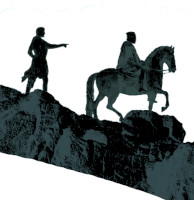There are five acres.
Three acres describe an open yard of grass and moss shaded to between 30% and 70% by a dozen scattered mature western red cedars. The sun, in winter slides south of the mountain and shines slantwise on the yard. The entire property is ringed by cedar sands mixed with maple, vine maple and alder. This is the last house on the grid, the single power line terminating at a cedar pole flying a large American flag.
The upper stand shades a north-south back access driveway to two three other homesteads, to campers, a mobile home and a small house. The main drive is a west to east private road that ends at a watershed access service road, barred by a steel gate. Above that gate, to the east, loom the dark green Cascades, licked in winter with white, gray and off white mists, fog and cloud banks.
When one climbs the shoulder of the mountain a half mile and turns he can see the Olympic Mountains across Puget Sound. Hiking two more miles, and taking to the crest of the saddle between the mountains, one may see to the east, for perhaps ten miles, the watershed, ending in an ominous wall of mountains. When one turns back around, on a clear day, Seattle comes into view, like a thumbnail of a comic book city full of bad guys in the blue distance, one black tower visible even from this distance. Most days, one just sees clouds, mist and rain.
Heading back down along the creek the end moraines, left from glacial pushing, are distant to the west towards the coast, clothed in dark green and waisted in lighter greens.
The creek can always be heard on the property, tinkling to the south, describing the southern border, between the stead and the private road. The stream flows under a bridge at the end of the Cedar Stead driveway, where it links the main. That driveway is built on an old railroad bed with a two-tiered pond to the east, complete with an island shaded by massive cedars. The creek snakes down and flows north to border the southern and western edge of the cedar stead. Last year I reversed the drainage of the washed out drive so that the water drains north into the pound through a culvert, building a 75 foot berm above the creek to the east.
This hoodrat engineering has held and was maintained at the end of this December by raking 20 wheel barrows of cedar palms, and maple and alder leaves and branches out of the gutters, culvert, berm and road bed. My third year maintaining this drive, includes filling five potholes with gravel and filling the gutters with larger filter stones. It took but a single afternoon.
It is obvious, that left unraked for three years, the organic material would build on the heavily wooded pond margin to the east, reversing the drainage down hill to the west again and beginning to wash out the road and berm, making it a watery gutter. The raked matter is all heaped on the back of the lower western berm. Behind the berm is raked a flat vehicle turn around that can be cut on a riding lawn mower, this section reclaimed from the blackberry that own the creek bank bend and reach out to the berm again. It will take another afternoon to uproot these and cast them over the bank.
Below the driveway to the creek, the west margin of the property is fifty feet lower than the railroad bed and the table of land between that old bed and the upper north-south driveway. The lower two acres are a tangle of cedar, alder and maple, bordering a cleared property owned by a man in the horse business. Indeed, this property was a horse farm, the back of the lower two acres overlooked by a huge red barn at the back northwest corner of the upper three acres.
The lower acreage is going to be beaten with access paths to harvest dead-fallen cedar and maple, and some standing snags left from old wind damage. Wind damage this past Christmas and New Years blew down three cedars, one maple and two alder on the property margins. More wood awaits in the lower 2 acres, hard to get to. The barn serves as a great tool shed, storage and lumber yard, twice the size of the small house.
Facing the path to the lower acres and the front of the barn, where a gas powered wood-splitter, quads, a cart and wheel barrows are kept, is a wood shed that holds 4 cords of wood. The Captain has towed the wood splitter around to the dead falls, hauled full into the yard with his powerful diesel pickup, and then cut into 16 inch rounds, where he splits the rounds into quarters with the great chisel like machine that African corrections officials would surely put to more practical human use.
The hoodrat grounds keeper of winter and the wife, Captain and youngest son haul branches, palms and thousands of pounds of cedar cones, to a back burn pile where the ground has been leveled with imported clay.
As I write, after a two weeks of attending the dead falls, the last half cord needs to be wheel barrowed down the hill to the woodshed. Behind the woodshed a platform yawns over the hollow to the creek below, where an outbuilding is already raised on a platform of beams next to the tallest cedar on the property.
The back door of the small house faces the camper where the third son lives, under a strongly built slanted shed. The patio below the back door is bordered on the east by the attached pump room, a room with no interior access that houses the well pump, food storage and serves as a guest room.
Every year sees numerous structural improvement to this property. This year, the Captain took off a month to attend the property with his hobo laborer. For 7 days, 5 days of which were rainy, with two nights of torrential rain, we burned, stoked, fed and kept a brush pile fire going on the back northeast quarter. I estimate that 120 wheel barrows of branches, palms, cones, leaves, blackberry briers and bark where fed into this fire. I raked for 16 hours. The ash will feed the garden, a small affair fenced ten feet to keep out elk and attached to a poultry house that will be described elsewhere.
There are two main battles to be fought to maintain this property and prevent it from reverting to the native cedar forest.
Blackberries grow among accumulated organic material and turn moss and grass into a thicket. Livestock, which are hoped to be raised here, need some grass. Blackberry briers are terrible, tenacious invaders that spread 16 feet a year, and continue to creep across the ground and sink more roots in winter. I have chopped some out. The rest will be ripped up in February before I go.
These thorny invaders are concealed by the cedar debris, a mass of seeding material that will result in small cedar, with alder and maple on the creek and road margins growing up and choking out the black berries, depriving them of sunlight. As we rake the Captain looks at me and says, “This wants to be a cedar forest. It’s a fight. I hate yard work. So my friend says, ‘Why the heck did you buy all that dirt,’ and I answered, ‘Because I can—why not, a man should have land, its biblical.’”
The grown cedars, after the rains, when winds come, pose a threat to the buildings. Kept sensibly far from the house, they also feed the wood stove that warms and keeps dry the living space. For now, they provide grazing for the elk, only one of which can be taken a year. Eventually though, goats and a cow might provide a real edible, landscaping workforce.
This place I have come to love as a winter home is a light green island in a dark green sea of waving giants.
Parts:
#2: That Dog Will Hunt
#3: Cribbage











